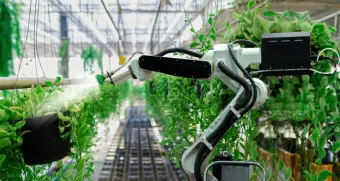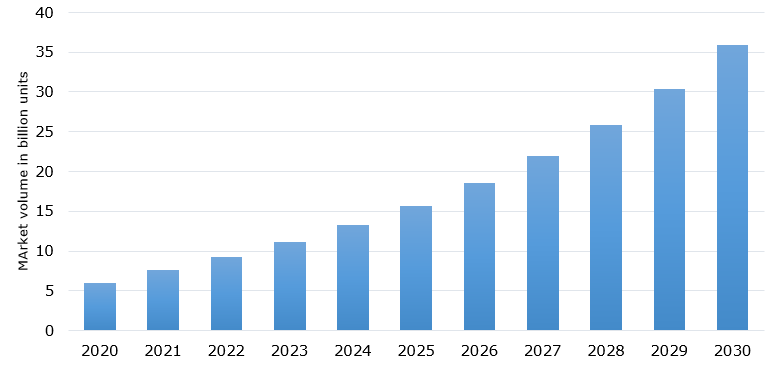5 Major Benefits of Adopting Robots in Agricultural Industry
01 Aug 2022 • by Natalie Aster

LONDON – Nowadays, in the wake of the rapidly increasing global population and surging demand for food, the agricultural sector is vitally important. At first glance it seems that farming hasn’t changed considerably since the dawn of civilization – people are still working in fields, growing and harvesting different plants, and raising animals to feed milliards of people worldwide. However, if we look closely, we’ll see that the agricultural industry is changing right before our eyes, and this transformation is faster than anyone would have thought.
The world’s population is projected to surpass 9.7 billion people by the year 2050, therefore, the volume of agricultural production will need to grow by no less than 70% from the actual level to serve the nutritional needs of the population. In light of this, automation and robotics are poised to play a crucial role in the agricultural sector in the foreseeable future.
Automation of the agricultural industry involves the substitution of old agricultural production techniques for modern automated technologies and robots to improve agricultural practices across such fields as farming, livestock breeding, fishery, greenhouse farming, and forestry, etc. Among other undeniable benefits of agriculture automation, one can name costs and losses reduction, and time-saving.
Automated agricultural machinery has a long development history. Notable progress was achieved during the 1970s, when electronics for control and monitoring was installed in agricultural machines. Today, we are facing “intelligent” machines able to exhibit the same physical and cognitive capacities as a human in performing various tasks in the agricultural sector, for instance, at every stage of the crop production cycle (from sowing to harvesting). Modern agricultural robots possess such attributes as perception, reasoning, control, learning, and supervision; they are able to analyse, contemplate, and accomplish a host of functions, furthermore, they can be programmed to evolve in order to match the needs of different tasks. Robots have already been penetrated across a great number of sectors in the agricultural industry and, presently, assist farmers in a broad spectrum of agricultural operations.
Last year the volume of the world’s market for agricultural robots was estimated at around 7.6 billion units. This year, the market volume is set to exhibit robust growth and total 9.3 billion units. The agricultural robots market is slated to maintain sustainable growth at a brisk pace and come to the volume of nearly 35.9 billion units by the year 2030.
The volume of the world’s agricultural robots market from 2020 to 2030 (in billion units)

5 Benefits of Bringing Robots to Agricultural Sector:
- Robots Boost the Efficiency of Agricultural Production
Modern agricultural robots are designed to perform a job so accurately that no one human operator would be able to do it manually. Routine agricultural operations can be automated with modern robotics technologies, thereby lowering labor costs as well as manpower required, in the wake of the labor shortage registered in the agricultural sector.
For instance, a single robotic strawberry harvester has the potential to harvest berries on a 25-acre area in approximately 3 days and replace 30 human workers. Furthermore, some robots are equipped with specially-developed vision systems to accomplish certain tasks that are too demanding or even impossible for human workers. While sorting vegetable and fruit harvests, for example, the pick and place robots are capable of performing sorting operations quickly and easily, which also involves the separation of rotten or defective vegetables and fruits from consumable ones. Although human employees can also do this, they would require much more time to accomplish the same task. Some robots can easily point out highly-fertile areas of farms and those that are poor, run temperature and soil humidity tests, carry out crop analysis, etc.
- Robots Provide a Steady Workflow
In contrast to human employees, robots don’t become tired or fall sick, they can work for long hours and even nonstop, and they don’t need a day off. In addition to the fact that agricultural robots can operate at full capacity, their accuracy remains high when compared with human employees, and this ensures the quality of the outcome. These advantageous features help to maintain consistency in the agricultural industry and, thereby, allow to provide a stable food production process. For instance, in sorting vegetables or fruits of a certain colour, one robot can complete the task single-handedly, which would take an entire day for a human worker.
- Robots Protect Human Workers from Potential Harm
The acceptance of robots in the agricultural sector for such tasks as spraying pesticides and herbicides can help to protect human workers from certain harmful effects that are associated with handling chemicals by hands or inhaling. Besides, robots can help to minimize the use of pesticides on farms by almost 80%. Agricultural robots can be designed to carry out spraying tasks closer to the target or from an elevated point with the use of a specially-designed robotic arm.
- Robots Help to Lessen Climate Changes
Automation technologies can make the agricultural sector more profitable and at the same time reduce the environmental footprint of the industry. Agricultural robots that can move autonomously (in greenhouses or open fields) promise safer, cleaner, and more eco-friendly agricultural future. Machines equipped with site-specific software can control the amount of fertilizer and pesticides used, whilst also curbing greenhouse gas emissions. Sensors and cameras installed on robots are capable of identifying parasites and pests, detecting weeds, and recognizing diseases; they are able to spray chemicals only on affected areas and, thus, reduce the use of chemicals on farms by targeting selected plants instead of whole fields. Furthermore, robots with built-in ultraviolet lights that are able to kill mildew on plants may considerably lessen the use of fungicides. In addition, the ongoing replacement of traditional, fossil-fueled agricultural machinery with electric ones charged from renewable sources of energy will help to minimise carbon emissions in the agricultural field.
- Robots Hold High Potential to Reduce Agricultural Production Costs
The agricultural industry encompasses a broad spectrum of activities. In crop farming, for instance, there is a need for labour force to prepare and cultivate the land, sow the seeds of various cultures, water crops, prune, weed, and reap the harvest, amid other activities. Animal fields, in their turn, need regular maintenance, and livestock need to be fed and taken care of in all the necessary ways. To do all these activities a sufficient human workforce is required, and this can be very expensive. Furthermore, many tasks may not even be pleasant for human employees. Collaborative agricultural robots can help to do all the above activities quickly and easily, and, which is important, to cut labour costs. Anywhere, around 20-50% of the total agricultural production cost accrues to the labour force (often includes remuneration for high-skilled work and traditional manual labour). The introduction of automation and robotics allows farmers to bring down these costs and improve production efficiency.
Challenges of Automation in Agricultural Sector
However, the agricultural industry automation still faces a number of challenges that must be overcome. High adoption and maintenance costs present one of the major barriers for farmers, especially across developing countries. Moreover, certain technical issues and rising concerns associated with equipment breakdown may also hinder the penetration of robotics in the agricultural sector.
Looking Forward
Whatever the case, the revolution in the agricultural industry is just around the corner. Whilst initially rather slow, the adoption of robotics in the agricultural sector is slated to gather momentum at a brisk pace in the coming years. Agricultural robots offer a path towards more efficient and sustainable agricultural practices through advancements in technologies, software, and production systems. Although robots are already involved in almost every agricultural activity, agriculture still offers great potential for automation and robotics. There is no doubt that the human element will always play a fundamental role in managing a farm, nevertheless fully autonomous equipment and vehicles are coming. To get the maximum benefits, farmers will need to combine their experience and knowledge with advanced technologies. The future of the world depends on the ability to feed more and more people with fewer resources available, and robotic automation looks like the key to success.
© MarketPublishers.com, 2022
Analytics & News
